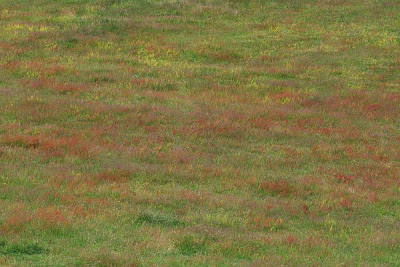Galium verum

Lady's Bedstraw has little yellow flowers, gathered in tufts at the top of the plant. A colony of Lady's Bedstraw reminds at a distance about a yellow carpet. The plant is common in a dry and sunny, grassy bottom, along roads, in sandy beach fields and in dunes. Lady's Bedstraw sends out a spicy, honey scent, which is especially strong before rain. Flowers in June-August.
Other names: Cheese-rennet / Cheese-running / Maid's-hair / Our lady's bedstraw / Petty Mugget / True Bedstraw / Yellow Bedstraw / Yellow lady's bedstraw / Yellow spring bedstraw
Folk medicine:
Lady's Bedstraw was used in skin problems and stomach diseases and as a sweat-impelling means. It was also an effective means against viper bite and other poisoning. It worked against gouts, cramps, stones in the kidneys and it was easening epilepsy. Children's scabies was given an effective bath with Lady's Bedstraw. It has also been used to combat sleeplessness. A decoction is good as an addition to hot water to soothe the feet of a weary traveller. In Europe, people have placed a piece of the plant in their shoes for protection against blisters.
 |
| pasture with common sorrel, Lady's Bedstraw and Festuca rubra |
Folklore:
Its common name probably derives from a Christian legend that claims it was part of the bedding used in the manger in which Jesus lay. It was believed that virgin Mary had plucked it as a bedstraw for baby Jesus, because the flowers were soft as a blanket. Before Christianity the flower was considered sacred and dedicated to the goddes Freja (Frigg), who is the goddes of love, marriage and home. The plant has been used as stuffing in pillows and mattresses, particularly for women about to give birth, as it was believed to ensure a safe and easy childbirth. Frigg helped women give birth to children, and as Scandinavians used the plant Lady's Bedstraw (Galium verum) as a sedative, they called it Frigg's grass.
Bedstraws are used as food plants by the larvae of some Lepidoptera species.
Practical use:
In the past the dried plants were used to stuff mattresses, as the coumarin scent of the plants acts as a flea killer. But it was also hanged up in the rooms, partly as a decoration, because the yellow colour lasts long like an eternelle, and partly as a source of scent because of the spicy aroma. Lady's bedstraw was also used to spice beer. In Denmark, the plant (known locally as gul snerre) is traditionally used to infuse spirits, making the uniquely Danish drink bjæsk.
Cheese
The latin name Gallium derives from the Greek ‘gala‘ that means milk. Lady’s Bedstraw is sometimes referred to as Cheese Rennet or Cheese Renning. This name corresponds to the common use of the plant as a milk curdler. The plant contains an enzyme suitable for this purpose. What makes this plant especially useful in cheese production is that as well as curdling milk, it also colours the cheese a bright yellow.The flowers were used to coagulate milk in cheese manufacture, and in Gloucestershire to colour the cheese.
 Among the other common names used for the plant is Maid’s Hair. The yellow dye that can be obtained from the stems, leaves and flowering tips has been used as a hair dye. Although it has never been widely cultivated for this purpose, a red dye can also be produced from the roots and has been used for dyeing wool and other fabrics in places like the Western Isles. The flower top was used to dye yellow and olive green. Galium, or Ladys' straw, was used as a red dye during Anglo-Saxon times in England.
Among the other common names used for the plant is Maid’s Hair. The yellow dye that can be obtained from the stems, leaves and flowering tips has been used as a hair dye. Although it has never been widely cultivated for this purpose, a red dye can also be produced from the roots and has been used for dyeing wool and other fabrics in places like the Western Isles. The flower top was used to dye yellow and olive green. Galium, or Ladys' straw, was used as a red dye during Anglo-Saxon times in England.Snaps/ Bjæsk: Use the flowers, it's best to use the buds just before flowering. They can be dried for later use, but not freezed. Put the flowers in a bottle, fill it with neutral snaps. Drawing time 1-2 days and not longer. After filter it has to be thinned. It's better when stored. The characteristic taste comes after storing it for a long time. photo Vilsted Lake and Strandkær, Mols 2007, 2008: grethe bachmann | |

4 comments:
Beautiful pictures. I do like the name Maid's Hair. I hope your followers remain and Google fixes the problem. I have linked successfully.
Hej Jack, thank you. Yes, Maid's Hair is a lovely name, and it actually sounds ancient and earlier than Lady's Bedstraw, since this lady was Virgin Mary of Christianity. I don't know which name is used the most in local places, but Lady's Bedstraw is mentioned as the first in the Liber Herbarum.
It seems that it has already been fixed on Google. Maybe it was not necessary to write about it. I always go bananas when something strange happens in the Google world!
Cheers
Grethe ´)
we have a couple varieties that stick together well
Hej Steve! well, I guess I should use the word the colour lasts or sustains instead of the word stick. I'll change that. Thank you!
Grethe
Post a Comment